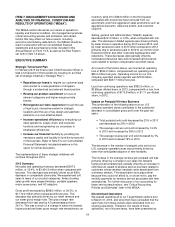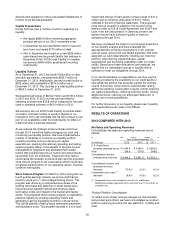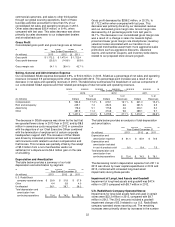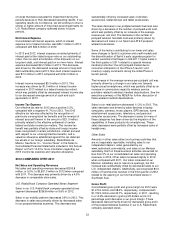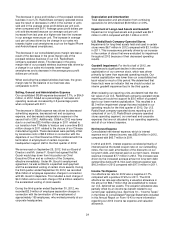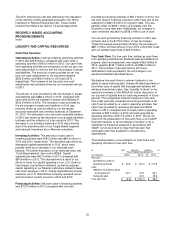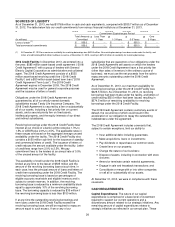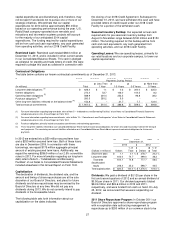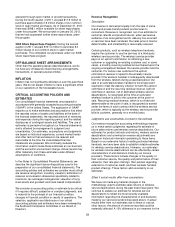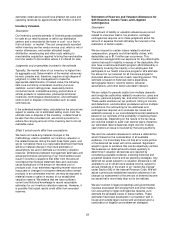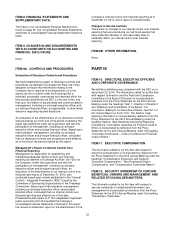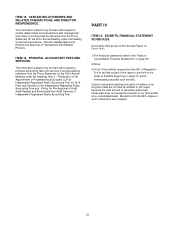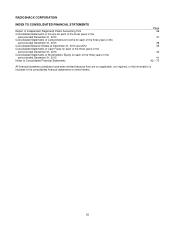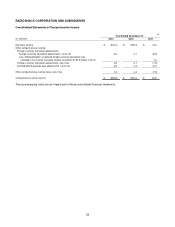Radio Shack 2013 Annual Report Download - page 31
Download and view the complete annual report
Please find page 31 of the 2013 Radio Shack annual report below. You can navigate through the pages in the report by either clicking on the pages listed below, or by using the keyword search tool below to find specific information within the annual report.29
estimates noted above would have affected net sales and
operating revenues by approximately $2.5 million in 2013.
Inventory Valuation
Description
Our inventory consists primarily of finished goods available
for sale at our retail locations or within our distribution
centers and is recorded at the lower of cost - on a first-in
first-out basis - or market. The cost components recorded
within inventory are the vendor invoice cost, which is net of
vendor allowances, and certain allocated freight,
distribution, warehousing and other costs relating to
merchandise acquisition required to bring the merchandise
from the vendor to the location where it is offered for sale.
Judgments and uncertainties involved in the estimate
Typically, the market value of our inventory is higher than
its aggregate cost. Determination of the market value may
be very complex and, therefore, requires a high degree of
judgment. In order for management to make the
appropriate determination of market value, the following
items are commonly considered: inventory turnover
statistics, current selling prices, seasonality factors,
consumer trends, competitive pricing, performance of
similar products or accessories, planned promotional
incentives, technological obsolescence, and estimated
costs to sell or dispose of merchandise such as sales
commissions.
If the estimated market value, calculated as the amount we
expect to realize, net of estimated selling costs, from the
ultimate sale or disposal of the inventory, is determined to
be less than the recorded cost, we record a provision to
reduce the carrying amount of the inventory item to its net
realizable value.
Effect if actual results differ from assumptions
We have not made any material changes in the
methodology used to establish our inventory valuation or
the related reserves during the past three fiscal years, and
we do not believe there is a reasonable likelihood that there
will be a material change in the future estimates or
assumptions we use to estimate our inventory valuation
reserves. Differences between management estimates and
actual performance and pricing of our merchandise could
result in inventory valuations that differ from the amount
recorded at the financial statement date and could also
cause fluctuations in the amount of recorded cost of
products sold. If our estimates regarding market value are
inaccurate or changes in consumer demand affect certain
products in an unforeseen manner, we may be exposed to
material losses or gains in excess of our established
valuation reserve. We believe that we have sufficient
current and historical knowledge to record reasonable
estimates for our inventory valuation reserves. However, it
is possible that actual results could differ from recorded
reserves.
Estimation of Reserves and Valuation Allowances for
Self-Insurance, Income Taxes, and Litigation
Contingencies
Description
The amount of liability or valuation allowance we record
related to insurance claims, tax positions, and legal
contingencies requires us to make judgments about the
amount of expense that will ultimately be incurred or the
realization of certain assets.
We are insured for certain losses related to workers'
compensation, property and other liability claims, with
deductibles up to $1.0 million per occurrence. This
insurance coverage limits our exposure for any catastrophic
claims that result in liability in excess of the deductible. We
also have a self-insured health program administered by a
third-party covering the majority of our employees that
participate in our health insurance programs. We estimate
the amount of our reserves for all insurance programs
discussed above at the end of each reporting period. This
estimate is based on historical claims experience,
demographic factors, severity factors, actuarial
assumptions, and other factors we deem relevant.
We are subject to periodic audits from multiple domestic
and foreign tax authorities related to income tax, sales and
use tax, personal property tax, and other forms of taxation.
These audits examine our tax positions, timing of income
and deductions, and allocation procedures across multiple
jurisdictions. Our accounting for tax estimates and
contingencies requires us to evaluate tax issues and
establish reserves in our consolidated financial statements
based on our estimate of the probability of realizing these
tax exposures. Depending on the nature of the tax issue,
we could be subject to audit over several years; therefore,
our estimated reserve balances might exist for multiple
years before an issue is resolved by the taxing authority.
We record a valuation allowance to reduce a deferred tax
asset if based on the consideration of all available
evidence, it is more likely than not that all or some portion
of the deferred tax asset will not be realized. Significant
weight is given to evidence that can be objectively verified.
We evaluate our deferred income taxes quarterly to
determine if valuation allowances are required by
considering available evidence, including historical and
projected taxable income and tax planning strategies. Any
deferred tax asset subject to a valuation allowance is still
available to us to offset future taxable income, subject to
annual limitations in the event of an “ownership change”
under Section 382 of the Internal Revenue Code. We will
adjust a previously established valuation allowance if we
change our assessment of the amount of deferred income
tax asset that is more likely than not to be realized.
We are involved in legal proceedings and governmental
inquiries associated with employment and other matters.
Our accounting for legal contingencies requires us to
estimate the probable losses in these matters. These
estimates have been developed in consultation with in-
house and outside legal counsel and are based upon a
combination of litigation and settlement strategies.


